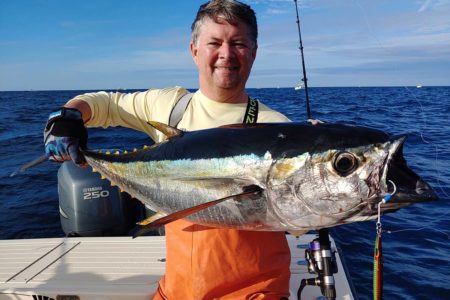
Don’t forget to renew your Atlantic highly migratory species (HMS) permit.
As a reminder, NOAA Fisheries requires all coastal fishermen to obtain an Atlantic highly migratory species (HMS) permit when targeting tunas, billfish, swordfish, or sharks.
For recreational fishing, either the HMS Angling permit or HMS Charter/Headboat permit is required for the boat, which allows anglers aboard those vessels to target and keep bluefin, yellowfin, bigeye, skipjack, or albacore tunas, as well as sharks and billfish (marlin and swordfish).
Just keep in mind too fishing for sharks with an HMS Permit also requires a shark endorsement. You’ll be prompted to view a video and take a quiz during the application process for an HMS Angling or HMS Charter/Headboat permit. The cost for an HMS Angling or Charter/Headboat permit is $26 at hmspermits.noaa.gov. As owner or operator of a vessel, you must also make the permit available for inspection upon request by any NOAA Fisheries or NOAA Fisheries-authorized personnel.
For most HMS Permit holder in our region, the first highly migratory species on the target list for 2023 is bluefin tuna. Effective January 1, the bluefin tuna daily retention limit is the default limit of one school, large school, or small medium bluefin from 27 to less than 73 inches, which applies to both the HMS Angling category-permitted vessels and HMS Charter/Headboat category-permitted vessels, and is effective for all areas except the Gulf of Mexico.
Angling and Charter/Headboat vessels may also land one bluefin measuring 73 inches or greater per vessel per year in all trophy areas. Until of course that “subquota” of bluefin harvest is met. Back on February 22, the National Marine Fisheries Service (NMFS) closed the Atlantic bluefin tuna Angling category fishery in the southern area for large medium and giant “trophy” bluefin 73 inches or greater; the southern area being south of 39°18’N (off Great Egg Inlet in South Jersey), outside the Gulf of Mexico.
“The intent of this closure is to prevent further overharvest of the Angling category southern area trophy BFT (bluefin tuna) subquota,” NMFS said at the time, noting that anglers may catch and release – or tag and release – bluefin of all sizes, subject to the requirements of HMS catch-and-release and tag-and-release programs.
Sometime soon, any day now, perhaps even today, NMFS could send another news blast out to hmspermits.noaa.gov/news that affects the trophy bluefin subquota north of Great Egg Inlet, which will have the social media sphere going bonkers. But it’s a regular occurrence, as tuna catches in the commercial and recreational sectors are highly monitored to maintain perfect poundage.
Unlike other coastal fisheries (summer flounder, black sea bass, etc.) which are monitored solely by the Marine Recreational Information Program, or MRIP which uses a combination of dockside intercepts and random sampling at home, all bluefin tuna and billfish catches (including swordfish) must be reported to NMFS to keep an ongoing tabulation of poundage.
Vessel owners/operators can report within 24 hours by accessing hmspermits.noaa.gov or using the HMS Catch Reporting App; reports can also be made by calling customer service at 888-USA-TUNA (888-872-8862) Monday through Friday 8 am to 5 pm EST.
In terms of HMS bag and size limits for 2023, the recreational yellowfin tuna retention limit is three per-person/day or trip. The minimum size for yellowfin and bigeye tuna is 27 inches curved fork length. There are no recreational limits for bigeye, skipjack, or albacore tunas.
A frequent question every year is whether or not it’s allowed to fish for tunas without a permit if an angler is not actually on a vessel. According to NOAA Fisheries, the answer is “No, only permitted vessels may fish for Atlantic bluefin, bigeye, albacore, yellowfin, and skipjack tunas in the Atlantic, Gulf of Mexico, and the Caribbean.” If one of these species is caught incidentally during fishing activities from shore, it must be released immediately.
It’s a shot in the dark that bluefin would show up in the surf at any point this season; it does happen of course from time-to-time, but there’s no way to get your 4WD buggy permitted to do so. But if you’re on a state-registered boat (or kayak for that matter) you can get that $26 permit from hmspermits.noaa.gov just in case the bite pops up where you might least expect it.





